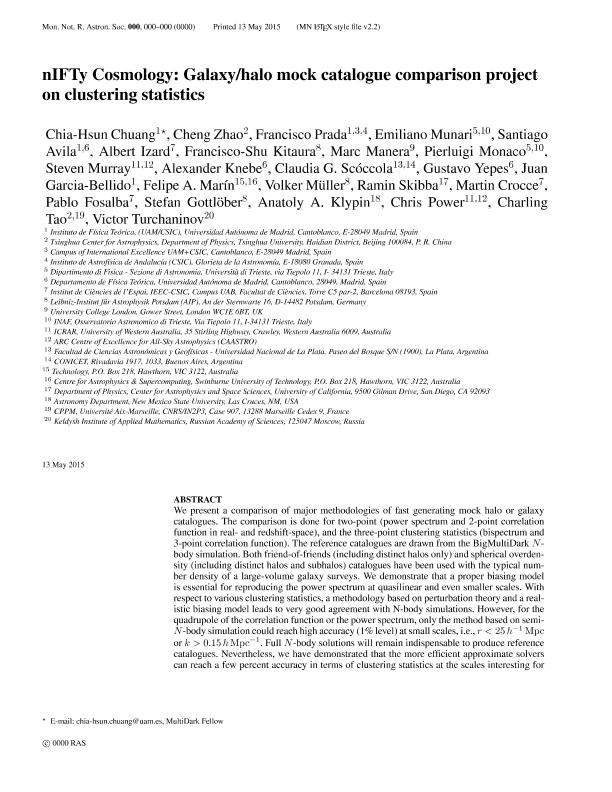Mostrar el registro sencillo del ítem
dc.contributor.author
Chuang, Chia Hsun
dc.contributor.author
Zhao, Cheng
dc.contributor.author
Prada, Francisco

dc.contributor.author
Munari, Emiliano
dc.contributor.author
Avila, Santiago
dc.contributor.author
Izard, Albert
dc.contributor.author
Kitaura, Francisco Shu
dc.contributor.author
Manera, Marc

dc.contributor.author
Monaco, Pierluigi
dc.contributor.author
Murray, Steven
dc.contributor.author
Knebe, Alexander
dc.contributor.author
Scoccola, Claudia Graciela

dc.contributor.author
Yepes, Gustavo
dc.contributor.author
Garcia Bellido, Juan
dc.contributor.author
Marín, Felipe A.
dc.contributor.author
Müller, Volker
dc.contributor.author
Skibba, Ramin
dc.contributor.author
Crocce, Martin
dc.contributor.author
Fosalba, Pablo
dc.contributor.author
Gottlöber, Stefan
dc.contributor.author
Klypin, Anatoly A.
dc.contributor.author
Power, Chris
dc.contributor.author
Tao, Charling
dc.contributor.author
Turchaninov, Victor
dc.date.available
2019-06-05T18:41:52Z
dc.date.issued
2015-04-08
dc.identifier.citation
Chuang, Chia Hsun; Zhao, Cheng; Prada, Francisco; Munari, Emiliano; Avila, Santiago; et al.; nIFTy Cosmology: Galaxy/halo mock catalogue comparison project on clustering statistics; Wiley Blackwell Publishing, Inc; Monthly Notices of the Royal Astronomical Society; 452; 1; 8-4-2015; 686-700
dc.identifier.issn
0035-8711
dc.identifier.uri
http://hdl.handle.net/11336/77652
dc.description.abstract
We present a comparison of major methodologies of fast generating mock halo or galaxy catalogues. The comparison is done for two-point (power spectrum and two-point correlation function in real and redshift space), and the three-point clustering statistics (bispectrum and three-point correlation function). The reference catalogues are drawn from the BigMultiDark N-body simulation. Both friend-of-friends (including distinct haloes only) and spherical overdensity (including distinct haloes and subhalos) catalogues have been used with the typical number density of a large volume galaxy surveys. We demonstrate that a proper biasing model is essential for reproducing the power spectrum at quasi-linear and even smaller scales. With respect to various clustering statistics, a methodology based on perturbation theory and a realistic biasing model leads to very good agreement with N-body simulations. However, for the quadrupole of the correlation function or the power spectrum, only the method based on semi-N-body simulation could reach high accuracy (1 per cent level) at small scales, i.e. r < 25 h-1 Mpc or k > 0.15 h Mpc-1. Full N-body solutions will remain indispensable to produce reference catalogues. Nevertheless, we have demonstrated that the more efficient approximate solvers can reach a few per cent accuracy in terms of clustering statistics at the scales interesting for the large-scale structure analysis. This makes them useful for massive production aimed at covariance studies, to scan large parameter spaces, and to estimate uncertainties in data analysis techniques, such as baryon acoustic oscillation reconstruction, redshift distortion measurements, etc.
dc.format
application/pdf
dc.language.iso
eng
dc.publisher
Wiley Blackwell Publishing, Inc

dc.rights
info:eu-repo/semantics/openAccess
dc.rights.uri
https://creativecommons.org/licenses/by-nc-sa/2.5/ar/
dc.subject
Cosmology: Observations
dc.subject
Distance Scale
dc.subject
Large-Scale Structure of Universe
dc.subject.classification
Astronomía

dc.subject.classification
Ciencias Físicas

dc.subject.classification
CIENCIAS NATURALES Y EXACTAS

dc.title
nIFTy Cosmology: Galaxy/halo mock catalogue comparison project on clustering statistics
dc.type
info:eu-repo/semantics/article
dc.type
info:ar-repo/semantics/artículo
dc.type
info:eu-repo/semantics/publishedVersion
dc.date.updated
2019-05-23T19:02:23Z
dc.identifier.eissn
1365-2966
dc.journal.volume
452
dc.journal.number
1
dc.journal.pagination
686-700
dc.journal.pais
Reino Unido

dc.journal.ciudad
Londres
dc.description.fil
Fil: Chuang, Chia Hsun. Universidad Autónoma de Madrid; España. Consejo Superior de Investigaciones Científicas; España
dc.description.fil
Fil: Zhao, Cheng. Tsinghua University; China
dc.description.fil
Fil: Prada, Francisco. Consejo Superior de Investigaciones Científicas; España. Universidad Autónoma de Madrid; España
dc.description.fil
Fil: Munari, Emiliano. Università degli Studi di Trieste; Italia. Istituto Nazionale di Astrofisica. Osservatorio astronomico di Trieste; Italia
dc.description.fil
Fil: Avila, Santiago. Consejo Superior de Investigaciones Científicas; España. Universidad Autónoma de Madrid; España
dc.description.fil
Fil: Izard, Albert. Consejo Superior de Investigaciones Científicas; España. Universitat Autònoma de Barcelona; España
dc.description.fil
Fil: Kitaura, Francisco Shu. Gobierno de la República Federal de Alemania. Max Planck Institut für Astrophysik; Alemania
dc.description.fil
Fil: Manera, Marc. University College London; Reino Unido
dc.description.fil
Fil: Monaco, Pierluigi. Università degli Studi di Trieste; Italia. Istituto Nazionale di Astrofisica. Osservatorio astronomico di Trieste; Italia
dc.description.fil
Fil: Murray, Steven. University of Western Australia; Australia. ARC Centre of Excellence for All-Sky Astrophysics; Australia
dc.description.fil
Fil: Knebe, Alexander. Universidad Autónoma de Madrid; España
dc.description.fil
Fil: Scoccola, Claudia Graciela. Consejo Nacional de Investigaciones Científicas y Técnicas. Centro Científico Tecnológico Conicet - La Plata; Argentina. Universidad Nacional de La Plata. Facultad de Ciencias Astronómicas y Geofísicas. Área Física Teórica; Argentina
dc.description.fil
Fil: Yepes, Gustavo. Universidad Autónoma de Madrid; España
dc.description.fil
Fil: Garcia Bellido, Juan. Universidad Autónoma de Madrid; España
dc.description.fil
Fil: Marín, Felipe A.. University of Technology; Australia. Consejo Superior de Investigaciones Científicas; España
dc.description.fil
Fil: Müller, Volker. Gobierno de la República Federal de Alemania. Max Planck Institut für Astrophysik; Alemania
dc.description.fil
Fil: Skibba, Ramin. University of California; Estados Unidos
dc.description.fil
Fil: Crocce, Martin. Universitat Autònoma de Barcelona; España
dc.description.fil
Fil: Fosalba, Pablo. Universitat Autònoma de Barcelona; España
dc.description.fil
Fil: Gottlöber, Stefan. Gobierno de la República Federal de Alemania. Max Planck Institut für Astrophysik; Alemania
dc.description.fil
Fil: Klypin, Anatoly A.. New Mexico State University; Estados Unidos
dc.description.fil
Fil: Power, Chris. University of Western Australia; Australia. ARC Centre of Excellence for All-Sky Astrophysics; Australia
dc.description.fil
Fil: Tao, Charling. Tsinghua University; China. Universite Aix-Marseille; Francia. Centre National de la Recherche Scientifique; Francia
dc.description.fil
Fil: Turchaninov, Victor. Russian Academy of Sciences; Rusia
dc.journal.title
Monthly Notices of the Royal Astronomical Society

dc.relation.alternativeid
info:eu-repo/semantics/altIdentifier/doi/http://dx.doi.org/10.1093/mnras/stv1289
dc.relation.alternativeid
info:eu-repo/semantics/altIdentifier/url/https://academic.oup.com/mnras/article/452/1/686/1749747
dc.relation.alternativeid
info:eu-repo/semantics/altIdentifier/url/https://arxiv.org/abs/1412.7729
Archivos asociados
